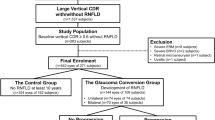Abstract
Purpose
To evaluate the incidence of non-glaucomatous ocular disease in patients with asymmetric optic disc cupping.
Methods
A retrospective case series, including consecutive patients with cup-to-disc ratio (CDR) asymmetry greater than 0.2. All patients underwent a complete neuro-ophthalmological examination, automated perimetry with the Humphrey 24-2 visual fields program. Retinal nerve fibre layer thickness was measured by optical coherence tomography (OCT). The results of neuroimaging, macular OCT and blood tests were recorded as well. Patients were assigned a diagnosis of glaucomatous optic neuropathy (GON) or non-glaucomatous disease (NGD). The main outcome measure was the rate of non-glaucomatous ocular disease.
Results
A total of 120 (67 males) patients with a mean age of 71.1 ± 12.5 years met the inclusion criteria and were included in this study. The mean asymmetry in CDR between the eyes was 0.3 ± 0.13 (range, 0.2–0.9). Twenty patients (16.6%) had a visual field defect not typical for glaucoma and positive relative afferent pupillary defect was found in 24 patients (20%). Six patients were found to have newly diagnosed non-glaucomatous ocular disease: maculopathy in three patients, retinopathy in one patient and traumatic optic neuropathy in two patients. Patients with NGD were significantly younger than the patients with GON (59.8 ± 23.3 vs. 71.3 ± 11.5 years, P = 0.001). Optic disc pallor was found in 4/93 patients with glaucoma compared to 3/6 with newly diagnosed non-glaucomatous disease (4.7% vs. 50.0%, P = 0.03).
Conclusions
Asymmetric optic disc cupping can be associated with non-glaucomatous disease and may warrant neuro-ophthalmological evaluation, especially in younger patients or those with optic disc pallor.


Similar content being viewed by others
References
Armaly MF (1967) Genetic determination of cup/disc ratio of the optic nerve. Arch Ophthalmol 78:35–43
Danesh-Meyer HV, Boland MV, Savino PJ et al (2010) Optic disc morphology in open-angle glaucoma compared with anterior ischemic optic neuropathies. Investig Ophthalmol Vis Sci 51:2003–2010
Bianchi-Marzoli S, Rizzo JF 3rd, Brancato R et al (1995) Quantitative analysis of optic disc cupping in compressive optic neuropathy. Ophthalmology 102:436–440
Kalenak JW, Kosmorsky GS, Hassenbusch SJ (1992) Compression of the intracranial optic nerve mimicking unilateral normal-pressure glaucoma. J Clin Neuroophthalmol 12:230–235
Hildebrand GD, Russell-Eggitt I, Saunders D et al (2010) Bow–tie cupping: a new sign of chiasmal compression. Arch Ophthalmol 128:1625–1626
Balo KP, Mihluedo H, Fany A et al (1998) Asymmetrical forms of primary open angle glaucoma. J Fr Ophthalmol 21:479–483
De Leon JM, Cheung CY, Wong TY et al (2015) Retinal vascular caliber between eyes with asymmetric glaucoma. Graefes Arch Clin Exp Ophthalmol 253:583–589
Foster PJ, Buhrmann R, Quigley HA, Johnson GJ (2002) The definition and classification of glaucoma in prevalence surveys. Br J Ophthalmol 86(2):238–242
Rebolleda G, Noval S, Contreras I et al (2009) Optic disc cupping after optic neuritis evaluated with optic coherence tomography. Eye (Lond) 23:890–894
Votruba M, Thiselton D, Bhattacharya SS (2003) Optic disc morphology of patients with OPA1 autosomal dominant optic atrophy. Br J Ophthalmol 87:48–53
Ortiz RG, Newman NJ, Manoukian S et al (1992) Optic disk cupping and electrocardiographic abnormalities in an American pedigree with Leber’s hereditary optic neuropathy. Am J Ophthalmol 113:561–566
Dias DT, Ushida M, Battistella R et al (2017) Neurophthalmological conditions mimicking glaucomatous optic neuropathy: analysis of the most common causes of misdiagnosis. BMC Ophthalmol 17:2
Fraser CL, White AJ, Plant GT et al (2013) Optic nerve cupping and the neuro-ophthalmologist. J Neuro-Ophthalmol 33:377–389
Ahmed II, Feldman F, Kucharczyk W et al (2002) Neuroradiologic screening in normal-pressure glaucoma: study results and literature review. J Glaucoma 11:279–286
Greenfield DS, Siatkowski RM, Glaser JS et al (1998) The cupped disc. Who needs neuroimaging? Ophthalmology 105:1866–1874
Kesler A, Haber I, Kurtz S (2010) Neurologic evaluations in normal-tension glaucoma workups: are they worth the effort? Isr Med Assoc J 12:287–289
Trobe JD, Glaser JS, Cassady J et al (1980) Nonglaucomatous excavation of the optic disc. Arch Ophthalmol 98:1046–1050
Chang DS, Xu L, Boland MV et al (2013) Accuracy of pupil assessment for the detection of glaucoma: a systematic review and meta-analysis. Ophthalmology 120:2217–2225
Kashiwagi K, Okubo T, Tsukahara S (2004) Association of magnetic resonance imaging of anterior optic pathway with glaucomatous visual field damage and optic disc cupping. J Glaucoma 13:189–195
Acknowledgements
None.
Funding
No funding was received for conducting this study. The authors have no relevant financial or non-financial interests to disclose.
Author information
Authors and Affiliations
Contributions
All authors contributed to the study conception and design. Material preparation, data collection and analysis were performed by OYB, MM, GD, ID and GR. The first draft of the manuscript was written by OYB, MM, DDG and all authors commented on previous versions of the manuscript. All authors read and approved the final manuscript. Authors are responsible for correctness of the statements provided in the manuscript.
Corresponding author
Ethics declarations
Conflict of interest
The authors have no conflicts of interest to declare.
Ethical approval
All procedures performed in studies involving human participants were in accordance with the ethical standards of the institutional and/or national research committee and with the 1964 Helsinki Declaration and its later amendments or comparable ethical standards. The study was approved by the Rabin Medical Center institutional review board (IRB), Israel.
Additional information
Publisher's Note
Springer Nature remains neutral with regard to jurisdictional claims in published maps and institutional affiliations.
Rights and permissions
About this article
Cite this article
Bialer, O.Y., Mimouni, M., Dotan, G. et al. Incidence of non-glaucomatous ocular disease in patients with asymmetric optic disc cupping. Int Ophthalmol 41, 2797–2804 (2021). https://doi.org/10.1007/s10792-021-01836-8
Received:
Accepted:
Published:
Issue Date:
DOI: https://doi.org/10.1007/s10792-021-01836-8




